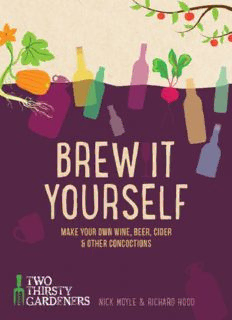
Brew it yourself : make your own wine, beer, hard cider and other concoctions PDF
Preview Brew it yourself : make your own wine, beer, hard cider and other concoctions
CONTENTS Foreword The Basics Wine & Mead rhubarb wine | elderberry wine | second-run elderberry & plum wine | elderflower wine | crab apple wine | fragrant fig wine | pineapple wine | grapefruit wine | lemon & lime wine | parsnip wine | mint wine | oak leaf wine | easy mead | rhodomel | winter mead Hard Cider farmhouse hard cider | cyser | pear & ginger hard cider | slider | bramble hard cider | scrumpleflower | rosehip hard cider | hopped hard cider | Rich’s hot toddy | lambswool Beer, Ale & Lager basic beer | London porter | India pale ale | wheat beer | lager | honey ale | Nick’s liquorice stout | raspberry ale | Viking ale | pumpkin ale | English brown ale | ginger ale Sparkling Drinks sima (Finnish spring mead) | tepache | canned fruit fizz | fizzy iced tea | elderflower sparkle | lavender sparkle | boozy dandelion soda | chili ginger beer | nettle beer Liqueurs sloe gin | second-run sloe whiskey | raspberry & thyme whiskey | damson & fennel vodka | wild brandy | crème de cassis & Kir Royale | rhubarb & vanilla liqueur | Julia’s orange whiskey | limoncello | rucolino | mint, lime & lemongrass liqueur | beech leaf & honey liqueur | mayflower brandy | Irish cream liqueur | coconut liqueur Classic Cocktails & Curios summer cup | cherry fortified wine | Rich’s sangri-ahhhhhh | bloody Mary | rumtopf | orange bitters | spruce bitters & spruce martini | vermouth | chili tequila & mango margarita | absinthe | horseradish vodka | spiced rum | marrow rum | Ilze’s beet kvass | egg-nog | glögg Ingredient Guides roots honey apples hops flowers berries herbs & spices FOREWORD For too long, the making of “homebrew” has been a pastime more commonly associated with folk of a certain age: those that favor sandal/sock combinations and hairy sweaters. Seen as a 70s throwback, this genteel pastime has long been mocked by the ignorant and uninformed. This is all about to change . . . We have bravely taken it upon ourselves to brew, ferment and infuse vast amounts of drinks from ingredients foraged, grown and scavenged in our gardens, on our allotment and sometimes—whisper it—from the store. Along the way, we have created gastronomic disasters too awful to recount, but that has all been part of the learning process. And we did it for you. This book contains a selection of our very best recipes, designed for a new generation of home brewers. It will provide inspiration for you to turn your own surplus harvest into tasty alcoholic beverages, explain how foraged ingredients can transform ordinary drinks into something wonderful, and demonstrate how anyone can create their own uniquely flavored booze. This book will debunk myths, celebrate experimentation and take the fear out of the science of fermentation. With ingredients varying from parsnips to pears and dandelions to damsons, we’ll be furiously fermenting, boldly brewing and magically mixing a weird and wonderful array of alcoholic drinks. Rise up, embrace the carboy and join us on our homebrew odyssey . . . it’s going to be one garden party you won’t want to miss! THE BREW-IT-YOURSELF MANIFESTO You don’t have to be a science expert or a Michelin-starred chef to get fantastic results through making your own booze, but we do try to follow a few guidelines to maximize the merriment. Here is our simple manifesto, which we have nailed to the door of our brewing shed to keep us on the straight and narrow. • Experiment! Swap ingredients to invent recipes, change base spirits in your liqueurs and add herbs and spices to just about anything. Try fermenting unusual produce . . . that unwanted vegetable lurking in the corner? It might just work! • Make copious notes, and keep them safe. All of your experimenting will go to waste if they are accidentally mixed up with the recycling, riding on the back of a cereal packet. • Taste is subjective. Remember, one person’s Chablis is another person’s drain cleaner. • Don’t get hung up over quantities. Treat measurements as a rough guide. Slightly more or less is rarely a problem. • Homegrown or foraged ingredients are best, but stores offer alternatives. There is no shame in purchasing produce in the pursuit of boozy beverages. • Sometimes being patient will reward you with improved drinks, but if it tastes good, enjoy it early. • Be generous and share your drinks. Receive feedback and take criticism graciously, no matter how misguided it may be. • ALWAYS treat alcohol with respect. Your hard work deserves it. BREW-IT-YOURSELF: THE BASICS T o make decent booze you need decent ingredients. The freshest, most flavorsome produce will always reward you with a higher quality of drink. We go into more detail about some of our favorite ingredients later, but here we’ll deal with the three main ways of acquiring them: grow them yourself, track them down when foraging . . . or buy them. GROWING YOUR OWN A lot of people begin their brewing journeys when they realize that surplus homegrown produce can be converted into alcohol. We know many gardeners with substantial rhubarb plants who are harvesting stalks long after they’ve tired of rhubarab pies, but don’t know what else to do with them. Point out how easy rhubarb wine is to make and there’s a good chance they’ll soon be scouring garage sales for their first carboy. Turning homegrown produce into tasty beverages is a hugely rewarding experience. And unlike most forms of cooking, where your hard-grown food is cooked and gobbled within hours, a bottle of booze will keep those flavors
Description: